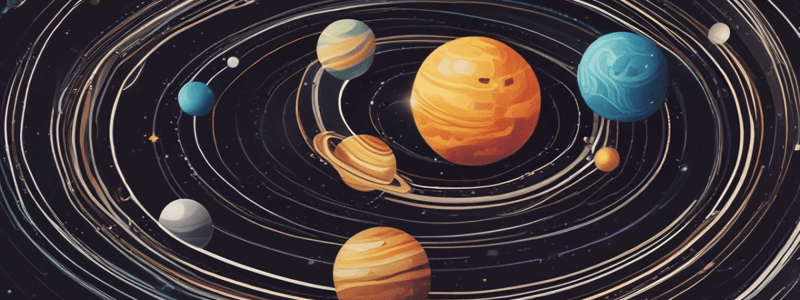Podcast
Questions and Answers
What is one astronomical unit (AU) equal to?
What is one astronomical unit (AU) equal to?
- The distance from Mercury to the Sun
- The distance from the Sun to the Moon
- The distance from the Earth to the Moon
- The distance from Earth to the Sun (correct)
What is the current tilt of the Earth's axis in degrees?
What is the current tilt of the Earth's axis in degrees?
- 26.1 degrees
- 30.2 degrees
- 23.4 degrees (correct)
- 20.5 degrees
What is the process called when the Earth's axis wobbles as it spins?
What is the process called when the Earth's axis wobbles as it spins?
- Revolution
- Precession (correct)
- Obliquity
- Rotation
Why do we experience seasons on Earth?
Why do we experience seasons on Earth?
What is the Giant Impact Hypothesis?
What is the Giant Impact Hypothesis?
What do the dotted lines in the diagram of Mercury's orbit represent?
What do the dotted lines in the diagram of Mercury's orbit represent?
What is the approximate time it takes for the Earth's axis to complete one wobble?
What is the approximate time it takes for the Earth's axis to complete one wobble?
What happens when the Northern hemisphere is tilted towards the Sun?
What happens when the Northern hemisphere is tilted towards the Sun?
What was the primary cause that led to the formation of our solar system?
What was the primary cause that led to the formation of our solar system?
What is the interaction between inertia and gravity responsible for in our solar system?
What is the interaction between inertia and gravity responsible for in our solar system?
What is the term for the slightly oval shape of planetary orbits?
What is the term for the slightly oval shape of planetary orbits?
Which planet in our solar system has the most orbital eccentricity?
Which planet in our solar system has the most orbital eccentricity?
What does inertia cause an object to do?
What does inertia cause an object to do?
What happens to objects in space with greater inertia than gravitational attraction during the formation of the solar system?
What happens to objects in space with greater inertia than gravitational attraction during the formation of the solar system?
What dominates the center of the disc that formed our solar system?
What dominates the center of the disc that formed our solar system?
Flashcards are hidden until you start studying
Study Notes
Formation of the Solar System
- The solar system formed about 4.6 billion years ago from a huge cloud of space dust and debris.
- Gravity caused the particles to come together and outside forces caused the cloud to spin, eventually flattening into a disc.
- The center of the disc became so hot and dense that nuclear fusion started, forming the sun.
- The remaining material in the surrounding cloud became orbiting planets.
Orbits
- The planets travel in the same direction and within the same plane in paths called orbits.
- An orbit is a path an object takes as it moves or revolves around another.
- Earth takes 365.25 days to orbit once.
- Objects in space orbit other objects due to the interaction between the forces of inertia and gravity.
Orbital Eccentricity
- The orbital paths of planets around the sun are often drawn as perfect circles, but they actually have a slightly elliptical or oval shape.
- The amount the orbital path deviates from a perfect circle is called its orbital eccentricity.
- Mercury has the most orbital eccentricity in our solar system.
- One AU (Astronomical Unit) is the distance from Earth to the Sun, used to measure distances in our solar system.
Earth's Tilt
- The axis of Earth is not perpendicular to its orbital plane but is actually tilted slightly, known as the obliquity of the ecliptic.
- The tilt of the Earth is currently about 23.4 degrees off perpendicular.
- The tilt is believed to be caused by a collision with a nearly planet-sized object, which also created the debris that became the Moon.
Precession
- As the Earth rotates and revolves, it also wobbles on its axis, similar to a spinning top.
- This circular wobble changes the angle of the tilt of Earth in a process called precession.
- One complete wobble or precession takes about 26,000 years.
Seasons
- The tilt of the Earth is the cause of seasons, not how close or far the Earth is from the Sun.
- Warm summers occur on the hemisphere of the Earth that is tilted toward the Sun, receiving direct sunlight.
- The opposite hemisphere, tilted away from the Sun, receives less direct rays and experiences winter.
- As the Earth orbits the Sun, the seasons change due to the orientation of the tilt relative to the Sun.
Studying That Suits You
Use AI to generate personalized quizzes and flashcards to suit your learning preferences.




